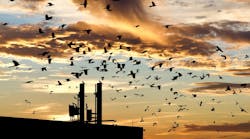Few things are more dangerous than buildings when it comes to bird health. In fact, only cats kill more birds per year. Even so, collisions with buildings cause 100 million to 1 billion bird deaths each year. From an ecological and structural standpoint, it is clear this is a problem that must be addressed.
From new projects under construction to retrofitting existing locations, bird-safe buildings are vital for the environment. Fortunately, advancements in glass technology and various legislative measures are leading the cause. With that in mind, here is BUILDINGS’ guide to a bird-safe building.
[Related: Bird-Friendly Building or Avian Abattoir?]
Why Are Buildings So Dangerous?
By far, glass is the leading culprit behind the danger of buildings. For every additional 10% of glass coverage, bird strikes go up another 19%. And as glass buildings continue to fill the skylines, bird deaths will only go up. However, make no mistake, high-rise buildings are not the main culprit. Buildings that are 10 stories and under account for the vast majority of collisions. In fact, 44% of all building-caused bird fatalities occur with those less than four stories tall.
Glass is dangerous for two main reasons: transparency and reflectivity. The first confuses birds into believing there is a clear passage to fly. Unfortunately, birds don’t understand the concept of a window; all they see is a lack of building. Consider a corner office with windows on each side. To a bird, that will appear as a clear passage. Other threat factors for glass include:
- Reflections that create confusing optical illusions
- Bird-attractive settings behind the glass, including gardens and trees
- Creating disorienting light sources at night
Indeed, lighting is the second-leading cause of bird-building incidents. Not only do unshielded lights cause light pollution, but they can also attract or disorient birds while they fly. This can bring them closer to the dangerous glass. Birds that migrate or travel at night are at additional risk. As they usually navigate by stars, artificial lights can disturb migration patterns.
The threats are severe. Because of this, guidelines have been established to improve the bird safety of building materials and designs.
How Can Bird Safety Be Achieved?
To be a bird-safe building, your facility must meet defined standards. The U.S. Green Building Council established these criteria under the LEED rating system. This rating considers an item’s threat factor to birds in its rating. Items with high threat factors are unsafe. This includes materials like transparent glass panes and unshielded lights.
According to the American Bird Conservatory, “bird-friendly” is defined as having a threat factor value of 30 or less. This rating correlates with a reduction of strikes by at least 50%. For a building to be bird-safe, 90% of its facade material (for the first 40 feet) must have a threat factor of 30 or less. Above 40 feet, 60% of materials must meet the requirement.
So, what materials meet these guidelines? Purpose-built windows are the first line of defense. Patterned glass is a simple way to reduce strikes almost immediately. Studies have shown that birds aren’t likely to fly through gaps of less than 2 inches high or 4 inches wide. Therefore, glass patterns following this rule can achieve a low threat factor. Patterned windows can come with UV reflective properties. This creates patterns that are invisible to humans, but visible to birds. A simple roll of tape can be used to achieve similar results.
Likewise, opaque and even stained-glass windows achieve lower threat values. If a bird can’t see through a window, it is unlikely to attempt to fly through it. Additional bird-safe and harm-reduction items include:
- Fritted windows with patterns of ceramic dots to radiate light away
- Netting, screens and shutters that obscure transparency and cushion impacts
- Non-toxic optical gel, which reflects UV light to redirect birds
- Strategic yards or roof-top gardens to give birds a safe space away from glass areas
- Opaque lights and lights-out programs to reduce light pollution
A building can earn its bird-safety rating through any combination of these means and, in doing so, earn LEED Pilot Credit 55 for bird safety. It is this LEED certification that highlights the true importance of bird-safe buildings.
[Related: New York’s Bird-Friendly Glass Policy is a Game-Changer for Buildings]
Why Are Bird-Safe Buildings Important?
Birds are more than just flying animals; they are vital to ecological well-being across the globe. Birds are some of nature’s most able cleaners. One vulture, for example, is responsible for over $10,000 worth of waste removal.
They are also massive contributors to pest control. Birds eat 400 to 500 million tons of insects every year. As such, they protect crops and help keep pest populations in check.
Birds contribute in many other ways, including:
- They are excellent pollinators, with 5% of all human-consumed plants pollinated by birds.
- Likewise, they spread seeds to continue ecosystems. In some areas, they are responsible for up to 70% of an area’s growth.
- They protect ecological balance by eating destructive herbivores that consume essential vegetation.
- They fertilize coral reefs with their potent guano and help keep rats off of islands.
Most importantly, bird-safe material is dropping in cost, and it has already been shown to be economically viable in new projects. In fact, in many cases, opting for bird-safe designs accounts for less than 1% of total costs. And as more attention is brought to the importance of bird-safe buildings, expect these prices to continue falling.
Striving to reduce ecological harm is at the forefront of the building industry. From emissions reduction to water quality, the building sector significantly impacts the environment.
Fortunately, the industry also stands at the forefront of beneficial change. Between continued legislation and the clear evidence for a protected environment, the time of transformation is now. Bird safety is well within reach for most building owners. With bird-safe glass and other facade features, this goal is easier to realize than other environmental steps.
About the Author:
Matthew Zajechowski is the director of media relations at North Star Inbound. Matthew is passionate about writing, content creation as well as sustainability and animal safety. Matthew earned his BA in Marketing at Western Michigan University.
Read next: How to Bird Proof Your Building – For Good



